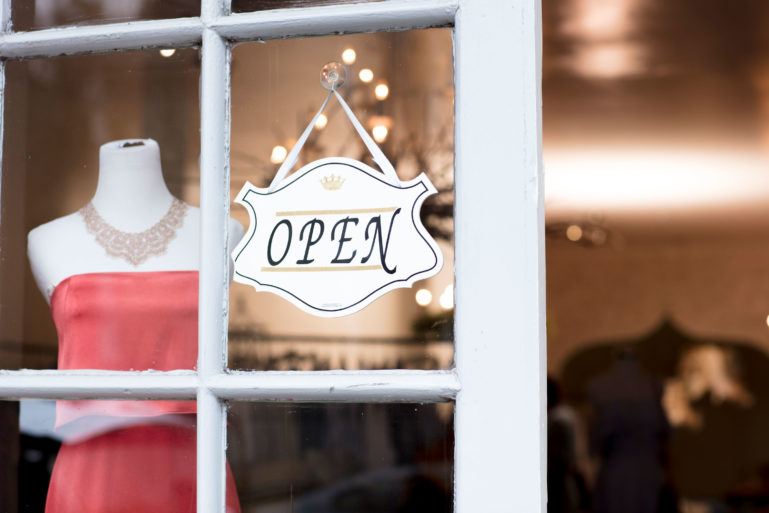
Opening Up A Retail Store? Here’s What You Need To Know
So, you’re thinking about opening up a retail store? In today’s digital age with same day eCommerce deliveries, your friends and family may think you’re crazy; but we see genius.
Traditional retail isn’t dying, it’s changing. While the COVID-19 pandemic might have permanently changed some of our spending patterns and shopping behaviors, some retail stores are actually growing, despite trends and articles that may suggest otherwise.
Selecting the right business structure, writing a detailed plan, and picking powerful tools that work together is more important now than ever to set your business up for success. We’ll help you do all of those things and more, so that your business can thrive in an ever-changing retail environment.
How to Start a Retail Store
- Define Your Legal Structure
- Write a Business Plan
- Pick Your Business Name
- Get Licensing and Permits
- Choose Your Business Tools
Define Your Legal Structure
Before you open your doors, you’ll need to decide on a legal structure for your business. Your legal structure will affect how you pay taxes, the amount of personal liability for any debts, your ability to raise capital, and have shareholders – all of which have a huge impact on your operations. We’ve laid out all of the different options so you can find the one that works best for you.
Sole Proprietorship
A sole proprietorship is the simplest legal structure in terms of taxes and paperwork, but that doesn’t necessarily mean it’s the best choice. Unlike the other business structures, you don’t need to fill out any formal paperwork to form your business. It also means you’ll only need to complete one tax return during tax time.
However, as a sole proprietor, a major downside is that you’re 100% liable and responsible for any debts from your business. If you fail to repay your business debts, your home, savings, and other personal assets may be used as collateral.
Partnership
A partnership is a legal agreement between two or more people to be co-owners of the business. Each partner can have varying degrees of vested interest depending on what type of partnership you set up. These are the different types of partnerships you can form:
General Partnership (GP)
With this kind of partnership, each partner participates in day-to-day operations and has control over the business. As co-owners, partners share liability for debts. This partnership works best if both partners want to have a say in the business’s management and operations.
Limited Partnership (LP)
Limited partnerships have a general partner that is responsible for day-to-day activities as well as a partner(s) who are not involved in the daily operations. The most common example of this would be a silent partner, or someone who provides capital for the business but is not involved in daily operations.
Limited Liability Partnership (LLP)
A Limited Liability Partnership (LLP) means two things:
- All partners share a limited amount of personal responsibility for the business.
- All partners can participate in management tasks and operations, if they want to.
This kind of partnership is popular with law firms, accounting firms, and other service professionals because it protects each partner from being responsible for the debts of the other partner.

Corporation
Corporations are one of the more complicated business structures to set up and maintain because they involve extensive record keeping, reporting, and tax requirements. This also means they cost more to operate. Like partnerships, there are varying degrees or different types of corporations you can form. It’s up to you and your partner(s) to decide which structure makes the most sense, given everyone’s interests.
C Corp
This kind of corporation is a legal entity that remains completely separate from its owner(s). The separate entity allows the corporation to make a profit, record losses, be taxed, and held legally liable independently from the owner. The biggest advantage of a C Corp is the protection from personal liability. The greatest disadvantage is taxation, because in some cases, corporations are taxed twice: once upon earning a profit and another when dividends are paid to shareholders.
S Corp
S Corporations are a popular option among retail store owners because they’re hybrids of a corporation and partnership. With an S Corp, profits and losses passed through the personal income tax of its owner(s) or shareholders, just like in a partnership. On the other hand, an S Corp also provides personal liability protection, just like a corporation would.
Limited Liability Company (LLC)
An LLC is a hybrid of a corporation and partnership. From a tax perspective, an LLC is most similar to a partnership. Profits and losses are passed through to the owner’s personal income tax, so there’s no need to file a separate corporate tax return. Limited Liability Companies also enjoy personal liability protection like corporations do.
Another way to think about an LLC is as a more formalized partnership. You’ll need to file official paperwork with your state, but you won’t need to hold annual meetings for directors or shareholders and keep detailed records of those meetings and major business decisions like you would if you were a corporation.
Once you have an idea of the legal structure you want to use, the next step is registering your business. Most of the time, this involves filing paperwork with your state’s Secretary of State Office, a Business Bureau, or a Business Agency. This varies state by state, so we recommend checking out the Small Business Administration’s page on registering your business.
SEE ALSO: How to Run a Profitable Business, (Minus the Costly Mistakes)
Write a Business Plan
Once you’ve settled on a legal structure, you can start drafting your business plan. Your business plan doesn’t need to be long and complicated, unless you plan to form a C Corp. Most retailers typically set up sole proprietorships, partnerships, or one of the hybrid structures where documentation is much easier to put together.
To start writing your business plan, a great first step is to fine tune your store’s vision and purpose. Ask yourself the following questions to figure out how you’ll set your business apart from what’s already out there:
- Why do you want to open a retail store in the first place? Are you serving a need or meeting a demand?
- Do you have any data (qualitative or quantitative) that proves this need exists?
- What are your business’s core values?
- Who will your customers be? What are their core values?
- What makes your idea or concept unique? Is there a business similar to yours nearby?
- What will set you apart from your competitors?
- How are you going to make money?
- What’s your timeline for breaking even or becoming profitable?
A business plan should act as an outline or roadmap for your business. It details your goals and gives answers as to how you plan to reach them, so that you have a framework in place to help you build and grow your business. Keep in mind that business plans are not set in stone and are meant to be flexible. They should be considered a work-in-progress that you’ll continually shape as your business evolves.
Here’s a list of what to include in your business plan:
Products and Services
This is where you’ll write down all your great ideas about why you’re going into business. List the types of products and services you’re going to provide, describe how they will be provided, include vendor and supplier information, and detail future areas for expansion.
Target Market
In this section, you’ll need to answer the these two main questions: 1. Who are your customers? and 2. Why should they buy from you over one of your competitors? Is it price, convenience, or high quality products?
Marketing Strategies
Your marketing strategy is where you can get creative and figure out how you’re going to bring in customers and what your brand stands for.
How are you going to get new customers? Are you going to market your business with social media posts, online ads, or blog posts? How are you going to generate press about your store’s opening? Are you going to reach out to local news sites or online publications? Are you going to set up profiles on Google My Business, Yelp, and other business search engines?
Pricing, merchandising, and future partnerships strategies are also areas you want to touch on under the marketing umbrella. For merchandising, you can describe the layout of your store. Are you going to put your items with the highest profit margin by the entrance of the store or are they things that need to be kept in countertop cases?
SEE ALSO: Retail Merchandising: Tips and Tricks for Growing Your Business
Future partnerships can include things like partnering with other local businesses or community organizations that complement your business, which would broaden your reach.
Employees and Staff
As much as you’ve said to yourself that you can do it all, chances are you’re going to have to hire some employees as you grow.
Describe what your staffing requirements will be by day of the week, peak times throughout the day, and any seasonal peaks that may be relevant such as back-to-school or holidays. How are you going to find your employees? Where are you going to post your open job listings? What does your screening and training process look like?
Financial Forecast
Last but not least, a business plan needs to include a financial forecast to estimate your revenue and expenses.
The best way to do this is with a pro forma statement. Typically, this is best done using historical data that can easily be pulled from a POS system like ShopKeep, to find your sales revenue and Cost of Goods Sold (COGS) on a monthly or yearly basis. You’ll also need to subtract your expenses and operational costs for the same period to determine your actual business performance – and use that to create your pro forma.
If you don’t have any data because you’re a new business, you’ll need to estimate these numbers. You can base them on things like your profit margins and growth from any marketing efforts so far. Don’t forget to subtract your projected start-up cost, which includes operating expenses such as payroll, and rent for retail space.
Pick Your Business Name
Your business name impacts every aspect of your business, so it’s important to pick one that reflects the brand identity you’re trying to create. Your business name can be anything from straightforward and logical to pun-filled and off-beat. If you’re having trouble coming up with a name, you can use a free business name generator to spark some ideas.
Once you have your business name nailed down, you will want to ensure that it isn’t already trademarked or in use. We also strongly recommend checking to see if the web domain name and corresponding Facebook, Instagram, Twitter, and Pinterest handles are available for your chosen name before registering your business. If available, make sure you claim your future website’s domain name and any matching social media handles immediately. Doing so will ensure that no one else can take them while you’re working on filling out any legal paperwork. It’s best if all of your social media handles are the same across every platform.
Get Licensing and Permits
Filing for business permits is probably the least exciting task on this list, but it’s definitely a must. If you open your doors without the proper permits and licenses, you might be charged with a criminal offense or a big fine depending on the laws in your state.
Employer Identification Number (EIN)
For U.S. based businesses, an EIN is like a social security number for your business. The good news is it’s super easy to get one; all you need to do is visit the IRS website and apply. You’ll get your EIN as soon as your application is completed.
State and Local Licenses
Since the federal government, states, cities, and counties have their own requirements for a business license, the best advice we can give you is to check with each agency to determine the proper ones needed for your business. The Small Business Administration (SBA) is a great resource for researching federal and state requirements. As for city and county agencies, this can either be done online or via a phone call.
One thing to note is that most retailers won’t require federal licensing. If you open a clothing boutique, chances are you won’t need a federal license to do so. But if you’re starting a wine shop or a vape shop, you will most definitely need a license from the federal government to sell such products.
Resale Certificate
As a retailer, you are going to buy products from vendors or distributors and then resell them to your customers. A resale certificate allows you to buy these items without paying tax to the seller. Use this interactive map to click on your state to find the right website to apply for your resale certificate.
Seller’s Permit
A seller’s permit allows you to sell your products in the state and also recognizes you as an entity that collects sales tax. To get one, you’ll need to visit your state’s department of revenue site.
Certificate of Occupancy (CO)
Any brick and mortar stores, or even pop-up up shops (depending on local regulations and how long they’re open for) will require a C of O. This ensures that your store’s building is in compliance with building codes and other laws that make it safe for employees and customers to visit. You can get a certificate of occupancy through your local government, such as your town or county’s building department or department of housing.
Choose Your Business Tools
Once you’ve registered your business and put together a business plan, your next step in starting up is choosing the right tools to make it easy to run and grow your business. Here are some of the major tools you’ll want to account for:
Retail Point of Sale (POS) System
A modern, cloud-based POS is a must for 2020 and beyond. Not only will this system allow you to process transactions with all major payment types (credit card, debit card, cash, NFC, etc.), but you also get access to advanced reporting, inventory management tools, and employee management capabilities that can help you grow sales and run your business more efficiently.
Payment Processing
In order to take credit card payments at your register, you’ll need to sign up for a payment processor. Payment processors take a small fee or percentage of each credit card sale, so it’s in your best interest to find a processor that saves you money in the long run. Those small fees add up over time and have a major impact on your business. A low fee, easy-to-use processor that offers fast payouts to your bank account is ideal for any retailer.
Tools for Today and Beyond
Keep your customers and employees safe by setting your store up with screen guards and contactless, signature-free credit card readers. Signing up for a mobile payments app to take payments whenever wherever will allow you to take sales beyond your store’s walls. Flexibility is key.
Accounting
Accounting can be one of the most frustrating aspects of running a small business, which is why we recommended signing up for an accounting software platform as soon as possible. To make things as simple as possible, you can select a system that connects with your POS system to allow for streamlined and accurate accounting. When the two are connected, your POS system records your daily transactions and syncs that data with your accounting software automatically, so that all of your numbers are ready to go come tax season.
Marketing
Marketing can be another challenge for small businesses, but there are a ton of tools and resources to make it easy. For example, you can use your POS system’s email integration tool to capture customer emails to send special promos directly to your existing customers. Your POS can also help you manage your business’s presence across sites like Facebook, Google, and Yelp and streamline your sales efforts across other channels like social media, eBay, and Amazon.
Ecommerce
In today’s world, online stores are a must. There are dozens of eCommerce platforms out there, and some are designed specifically for retail businesses looking to sell online. Platforms like ShopKeep eCommerce make it easy to build a fully-functional, well-designed online store, even if you’re not tech savvy. By choosing an eCommerce platform that integrates with your point-of-sale register, your inventory will be synced across online and in-store transactions.
The Bottom Line
There’s a lot you’ll need to consider before your store’s grand opening, but doing all of the necessary paperwork, research, and planning upfront will better prepare you to manage a successful business. Opening a retail store isn’t easy, but there are a ton of tools that make it easier. Get your business started with ShopKeep’s full suite of commerce solutions to sell in person, sell online and adapt to what comes next.
Want to try ShopKeep for yourself?
Just answer a few easy questions.
Need help finding the right point of sale?
Just complete the form. We’ll call you right back to explain how ShopKeep can work for you.
Hit the ground running.Sprinting, in fact!
Read our free, comprehensive guide, Small Business 101, to learn all you need to know about starting a thriving business.

